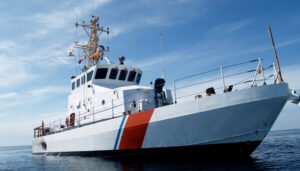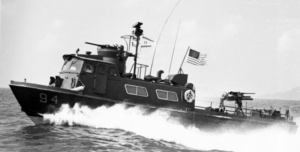Asbestos — a cancer-causing substance — was used in almost every U.S. Navy patrol boat before the early 1980s. Service members aboard these naval vessels could have been exposed to asbestos dust, putting them at risk of mesothelioma, asbestosis, lung cancer, or other health problems later in life. Pursue benefits from the U.S. Department of Veterans Affairs (VA) and private sources if you or a loved one got sick.
Asbestos and Patrol Boats Explained
Patrol boats are some of the smallest ships in the U.S. Navy. These vessels are built for coastal defense and the transport of sailors and supplies. They are light and fast, capable of skimming coastlines and waterways.
Unfortunately, U.S. Navy patrol boats and many other vessels were built with a cancer-causing material called asbestos for decades. Asbestos was used for fireproofing and insulation on patrol boats.
 Working with materials made out of asbestos can send tiny fibers flying into the air. When asbestos becomes airborne, those nearby can inhale the substance and develop mesothelioma (a deadly cancer) or other asbestos-related diseases 10-50 years later.
Working with materials made out of asbestos can send tiny fibers flying into the air. When asbestos becomes airborne, those nearby can inhale the substance and develop mesothelioma (a deadly cancer) or other asbestos-related diseases 10-50 years later.
Thankfully, veterans with mesothelioma can pursue health benefits and compensation from the VA. They can also seek compensation by filing private claims against the makers of asbestos-based products. Learn more about the benefits available by getting our Free Veterans Packet.
How Patrol Boat Service Members Were Exposed to Asbestos
Even ships as small as Navy patrol boats needed excellent insulation to reduce the risk of onboard fires.
Since asbestos was fire resistant and a great insulator, it was once used throughout patrol boats, including engine rooms, boiler rooms, and anywhere else that contained piping or other parts that needed insulation.
Places where you could find asbestos on patrol boats included:
- Adhesives
- Boilers
- Deck covering material
- Engines
- Gaskets
- Pipes/pipe insulation
- Pumps
- Turbines
U.S. Navy veterans that served aboard patrol boats had to install, repair, or replace asbestos-based components. However, these activities could release asbestos fibers into the air, putting anyone nearby at risk of mesothelioma.
Who Was at Risk of Asbestos on Navy Patrol Boats?
Anyone who served on a Navy patrol boat or other vessels could have been exposed to asbestos. That said, some Navy sailors were at a greater risk than others.
Typically, boilermen and pipefitters had the highest risk as they worked directly with asbestos-containing products like broken gaskets, valves, and piping insulation.
Other Naval personnel at risk of asbestos on patrol boats included:
- Electrician’s mates
- Engine tenders
- Machinist mates
- Minesweepers
- Shipfitters
- Shipyard workers
Navy patrol boats are small, so many worked above deck. However, those working in poorly ventilated spaces around asbestos-based products below deck could have easily inhaled stray fibers.
Servicemen responsible for repairs on these crafts had the highest risk of exposure to asbestos on patrol boats.
 Those working on patrol boats in shipyards were also at risk of asbestos exposure. Shipyard workers had to replace and remove asbestos-based products on a regular basis — activities that could have easily exposed them to the dangerous fibers.
Those working on patrol boats in shipyards were also at risk of asbestos exposure. Shipyard workers had to replace and remove asbestos-based products on a regular basis — activities that could have easily exposed them to the dangerous fibers.
File for VA benefits now if you developed mesothelioma after serving on a patrol boat or another Navy vessel.
List of Patrol Boats That Used Asbestos
Over 500 patrol boats built with asbestos-containing materials were used during World War II alone.
These included:
- USS Antelope (PG-86)
- USS Asheville (PG-84)
- USS Beacon (PG-99)
- USS Canon (PG-90)
- USS Douglas (PG-100)
- USS Gallup (PG-85)
- USS Grand Rapids (PGM-98)
- USS Pegasus (PHM-1)
- USS Surprise (PG-97)
- USS Susanville (PC-1149)
- USS Tacoma (PG-92)
- USS Tucumcari (PGH-2)
There are many different patrol boats designed for unique purposes. Some — known as torpedo boats — were built to launch missiles, while other patrol crafts were meant for troop transport.
Major classes of Navy patrol boats built with asbestos included:
- Coastal yacht
- Escort
- Gunboat
- Gunboat hydrofoil
- Missile hydrofoil
- Motor gunboat
- Patrol craft
- Patrol frigate
- Patrol yacht
- Rescue escort
- River gunboat
- Submarine chaser
- Sweeper
- Torpedo boat
By the 1970s, patrol boats and other Navy vessels relied less and less on asbestos. The USS Pegasus, for example, didn’t use asbestos insulation. However, this vessel’s bulkheads were made of asbestos-containing martinite.
Patrol boats made after the early 1980s do not contain asbestos. Just over a dozen Navy patrol boats are currently on active duty, while more than 250 patrol boats serve the U.S. Coast Guard.
Benefits & Compensation for Patrol Boat Veterans With Mesothelioma
Veterans who became ill from asbestos exposure on patrol boats or other Navy vessels can receive benefits from both the VA and private sources. These benefits include free or low-cost medical care, financial compensation, and more.
Top options for veterans with mesothelioma include:
- Asbestos trust funds: Many companies that made the asbestos products used in patrol boats set up trust funds to ensure these victims get payment. More than $30 billion is available in all asbestos trust funds right now. A knowledgeable law firm can help you learn if you qualify.
- Mesothelioma lawsuits: Some companies did not establish asbestos trust funds, and if they’re still in business it may be possible to file lawsuits against them. Mesothelioma lawsuits often award $1 million and the Navy and government aren’t sued.
- VA benefits: Veterans with mesothelioma can receive $3,946.25 or more a month through the VA by applying for disability compensation. They can also access treatment from top mesothelioma doctors through the VA health care system.
Learn how to pursue VA benefits and other compensation options right now: Call (877) 450-8973 to get started.
Help for Veterans Exposed to Asbestos on Patrol Boats
The extensive use of asbestos on patrol boats and other Navy ships put many service members at risk of mesothelioma. That’s why the VA offers a wide range of benefits for veterans whose mesothelioma is connected to their military service.
Navy veterans with mesothelioma make up 33% of all cases of this cancer today. No branch of the military has more cases of mesothelioma than the Navy.
 The extensive use of asbestos on Navy ships up to the 1980s made it virtually impossible for seamen not to experience some kind of asbestos exposure. That’s why the VA offers 100% disability for veterans whose mesothelioma is connected to their military service.
The extensive use of asbestos on Navy ships up to the 1980s made it virtually impossible for seamen not to experience some kind of asbestos exposure. That’s why the VA offers 100% disability for veterans whose mesothelioma is connected to their military service.
Key points to remember:
- Though small, many patrol boats still posed a real asbestos risk.
- Veterans with mesothelioma may be eligible for VA benefits.
- Veterans with VA health care can get treatment from top mesothelioma doctors.
If you served in the U.S. military and have mesothelioma, our VA-accredited representative can explain the benefits you’re eligible for as well as your treatment options. See if you can file for VA benefits today.
Asbestos on Patrol Boats FAQs
What are patrol boats made of?
For decades, the U.S. Navy's patrol boats were built with asbestos-containing materials like insulation, piping, and gaskets.
Asbestos was used on these boats due to government mandates.
It was believed that asbestos was safe to use because private manufacturers hid the health risks.
Anyone exposed to asbestos on patrol boats could be at risk of mesothelioma 10-50 years later.
Do old boats contain asbestos?
Further, no patrol boats that were built with asbestos are still in use, according to a review of the Naval Vessel Register.
This doesn’t change the fact that many U.S. Navy veterans were already exposed to asbestos on patrol boats and other ships before the risks were known.
Today, one-third of mesothelioma patients served in the U.S. Navy or worked in a shipyard.
When did the military stop using asbestos?
The military stopped using asbestos on patrol boats and other vessels in the 1980s as the health risks became apparent.
Steps were also taken to remove asbestos-based products from all existing Navy vessels.
The VA has since established programs, including health care and financial aid, for veterans with mesothelioma.
What are my options if I was exposed to asbestos on a patrol boat?
If you or a loved one served on a U.S. patrol boat that used asbestos, keep an eye out for changes in your health.
Report any symptoms — like chest pain or a cough that won’t go away — to a doctor immediately, and be sure to tell them about your asbestos exposure.
If you have mesothelioma, you may qualify for monthly payouts and health care from the VA. You can also pursue money through trust fund claims and private lawsuits.
Call (877) 450-8973 to learn more about your options.


